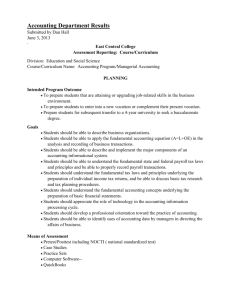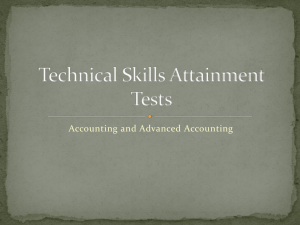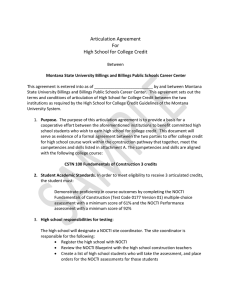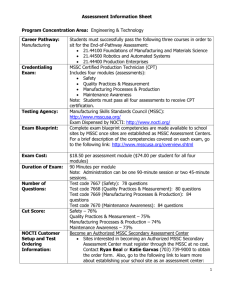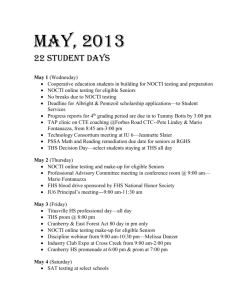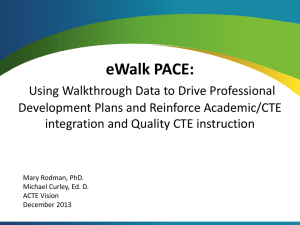NOCTI Overview - MnSCU CTE - Career Technical Education
advertisement
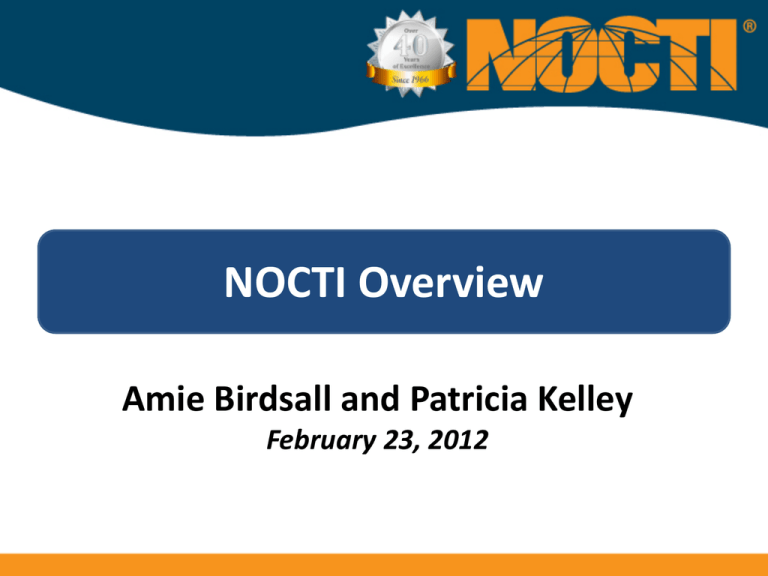
NOCTI Overview Amie Birdsall and Patricia Kelley February 23, 2012 Discussion Topics NOCTI Overview Products and Services Selecting an Assessment CTEDDI Q&A NOCTI Overview Over 40 years serving the CTE community Non-profit organization Owned and operated by the 50 states Each state is a member of NOCTI’s Consortium of States Works with both secondary and post-secondary populations Nocti Business Solutions (formerly The Whitener Group) provides services to industry NOCTI Overview - Educational Partners NOCTI Products & Services Assessments Over 80 Job Ready tests offered 30 Pathway tests in 10 clusters available Over 90 private industry employment and/or advancement tests delivered 20 teacher-level assessments Supplemental Products Study guides for all Job Ready and Pathway assessments Countdown Kits available for all Job Ready assessments Successful Schools-Successful Programs Guide Professional Learning Opportunities Also Offered! Selecting an Assessment Determine purpose of assessment Determine audience Determine results desired Research available options Selecting an Assessment Selecting an Assessment Assessment blueprints are available on NOCTI’s website at no cost! www.nocti.org Assessment Blueprints • Blueprints include: • Competency List • Content Distribution • Sample items/jobs Assessment Blueprints Content distribution for written and performance Sample multiplechoice questions Sample performance job Job Ready Assessments Assess technical skills at the occupation level (e.g., Accounting, Carpentry, Pre-Engineering) Measure aspects of occupational competence such as factual and theoretical knowledge Target secondary and post-secondary program completers NOCTI Job Ready Assessment Blueprint Plumbing 8% Safety 10% Plumbing Math 24% General Plumbing Practices 9% Joining Pipes and Fittings 8% Drainage Vent Installation Water Supply and Distribution Hot Water Systems Traps Installing Fixtures Plumbing Service and Repair 4% 7% 6% 8% 7% 9% NOCTI Job Ready Assessment Blueprint Number of Questions: 222 Areas Covered: Accounting NOCTI Pathway Assessment Blueprint Construction Pathway General Architecture & Construction Technical Skills 15% Construction 15% Academic Foundations 15% Systems 6% Ethics and Legal Responsibilities 6% 8% Communication Information Technology Applications Problem Solving, Critical Thinking, and Decision Making Leadership and Teamwork Safety, Health, and Environment Employability and Career Development 5% 7% 6% 8% 9% Assessment Results NOCTI’s Standard Score Reporting Package: Individual Score Reports Group Score Reports Comparative Data Other Reports Available: Task-Link Reports Integrated Academic Reports What data do I receive from NOCTI? Score Reports Online Test Administration Immediate Score Reports Paper/Pencil Administration Aggregate Reports: 10 business days after receipt of Aggregate Reports: correctly 2 business days completed answer after user codes are sheets released from Client Services Center What data do I receive from NOCTI? Immediate Score Reports Immediate Student Scores Displayed to student if option is designated Emailed to Site Coordinator upon completion of testing (can be forwarded to instructor) NOCTI Standard Score Reports Individual Score Reports • Provided for each test taker • Scores by duty and total • Pre-/post-test comparisons • Comparative data NOCTI Standard Score Reports Group Score Report • Provided for the testing group • Duty and total scores for each participant NOCTI Standard Score Reports Analysis of Scores Report • Provided for the testing group • Comparative data • Criterionreferenced cut score • Other statistical information NOCTI Additional Reports: Task-Link Report Task-Link Report • Includes: • Number of items presented for each task • Average correct by group • Number correct for each test taker Project Goals • • • • Understand data and assessments Use data effectively Improve learning and skill acquisition for students Plan for continuous improvement of learning and instruction • Share ideas and collaborate with other educators Instructional Improvement Cycle Classroom Example A Nursing Assisting Class Areas on a Nursing Assisting Test Basic Nursing Assisting 8% Infection Control 8% 28% Communication Skills Personal Care Skills 13% 10% 10% Mental Health/Social Needs Client’s Rights Basic Restorative Devices 13% 10% Employability Skills Individual Nursing Pretest Pretest % Correct Student 1 Posttest % Correct Student 1 Basic Nursing Assisting 54.6 -- Infection Control 30.0 -- Communication Skills 41.1 -- Personal Care Skills 36.4 -- Mental Health/Social Needs 53.8 -- Client’s Rights 36.4 -- Basic Restorative Devices 50.0 -- Employability Skills 27.3 -- Nursing Assistant Pretest Areas Total 43.4 Nursing Assisting Pretest Nursing Assistant Pretest Areas Student 1 % Correct Student 2 Student 3 Student 4 % Correct % Correct % Correct Student 5 Student 6 % Correct % Correct Class Average % Correct Basic Nursing Assisting 54.6 45.5 42.7 27.3 27.3 54.5 41.9 Infection Control 30.0 20.0 10.0 20.0 10.0 30.0 20.0 Communication Skills 41.1 17.6 23.5 23.5 13.2 35.3 25.7 Personal Care Skills 36.4 54.5 45.5 45.5 36.4 54.5 45.5 Mental Health/Social Needs 53.8 38.5 42.3 38.5 20.8 53.8 41.3 Client’s Rights 36.4 36.4 38.3 36.4 22.5 45.5 35.9 Basic Restorative Devices 50.0 60.0 50.0 60.0 30.0 80.0 55.0 Employability Skills 27.3 18.2 18.2 27.3 9.1 27.3 21.2 43.4 38.4 35.9 38.5 22.8 48.8 38.0 Total Nursing Assisting Posttest Nursing Assistant Pretest Areas Student 1 % Correct Student 3 Student 5 % Correct % Correct Group Site State Nation Basic Nursing Assisting 100.0 92.4 76.2 86.4 79.5 72.5 75.5 Infection Control 91.7 94.5 72.4 79.2 78.2 70.7 70.6 Communication Skills 100.0 100.0 55.3 95.0 83.8 64.3 66.4 Personal Care Skills 92.3 54.5 52.5 69.2 65.8 51.6 52.9 Mental Health/Social Needs 97.4 72.5 60.3 71.8 69.8 63.1 64.1 Client’s Rights 84.8 66.4 44.7 64.6 67.6 58.1 57.8 Basic Restorative Devices 87.5 60.2 45.2 53.1 61.9 55.6 56.5 Employability Skills 87.5 78.5 37.4 79.7 75.6 66.6 67.0 93.9 79.4 58.4 76.8 73.7 64.1 65.2 Total What the Data Reveal • Achievement gaps • Differences between subgroups • Trends • Progress Collecting Data – More Than NOCTI • Includes process of collecting, analyzing, and interpreting information • Determines the degree to which students are becoming competent and meeting standards • Occurs at many levels (e.g., classroom and program assessments to state and national assessments) What Data Exist? • National • State • District/System • School • Program • Teacher • Class • Student • Standards Icebergs What lies beneath the data scores that influence those scores? What Questions Can the Data Answer? • What is the data designed to answer? • What other data may be needed? • What roadblocks are there to interpreting the data? Plan for Learning Improvement • Start with results: Analyze the previous year’s goals, comparing against local unit tests and end-of-course tests, at the student level and classroom level. • Triangulate: Find relationships between test data and attendance and discipline referrals. Plan for Learning Improvement Continued: • Disaggregate data by subgroups (e.g., socioeconomic status or those receiving free/reduced lunch, or Individualized Education Program/IEP). • Use information from advisory groups or parents. • Set goals for the year as well as long-term goals. Plan for Learning Improvement Continued: • A common denominator is to improve learning through teamwork. • Build school department and state data teams. • Review annual assessment data with a faculty team to isolate achievement gaps or groups of students with high and low performance. Plan for Learning Improvement Continued: • Schedule school and department data team meetings to discuss data and review progress. • Discuss and develop strategies, such as curricular alignment with academic and industry standards, curricular sequence, timing, and depth of instruction. Monitor Student Progress • Use a progress monitoring system for all students. • Graph students’ curricula-based scores. • Identify effective instructional components. Thank You Amie Birdsall Amie.Birdsall@nocti.org Pat Kelley Patricia.Kelley@nocti.org
